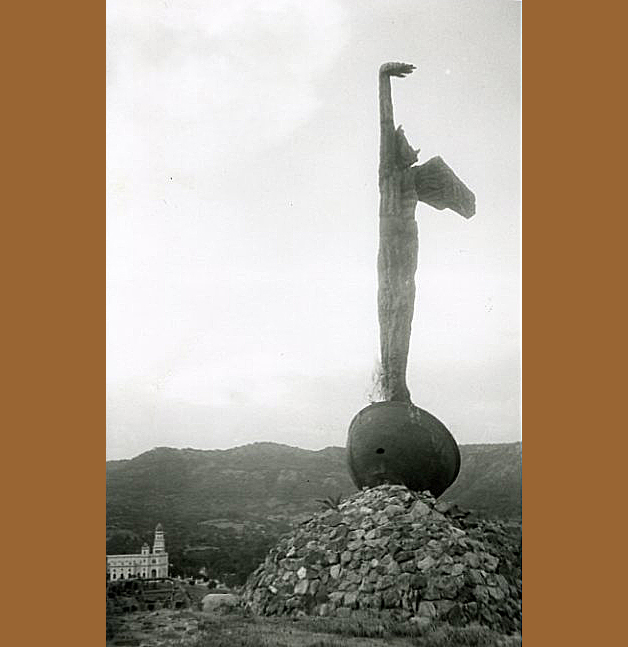
Click on thumbnails below to view full-size images and further commentary
  
|
| < |
Monumento al Cimarrón, iron and bronze sculpture by Alberto Lescay, El Cobre, 1997. Sponsored by Casa Caguayo, Casa del Caribe and UNESCO. |
El Cobre has been for the most part associated with the sanctuary to the Virgin of Charity, which itself constitutes a site for the commemoration of events from the past associated with a Christian tradition and some Afro-Cuban related ones. The "Marian cult and related traditions" section points to various commemorative aspects of those interlocked religious traditions, the sublte politics crisscrossing them, as well as the more strident politicization to which some sites have also been subjected. In 1997, another less known strand of the past became memorialized in El Cobre with the inaguration of the Monument to the Cimarrón, the "Runaway slave," on top of one of the hills surrounding the village, near the Mina Mayor. The Virgin's sanctuary and the giant Runaway slave sculpture both protrude from the hilly terrain also punctured with excavated mines as if infusing, or overwriting, the landscape with the history they represent and the past they commemorate. The sites can be regarded either as complementing each other or as competing for attention and allegiances, depending on identities and political outlooks in the present and readings of the past.
Aside from the sculpture's significance as a piece of art and the artistic vision it represents, the Cimarrón monument's site has also become an important public locus for the enactment of Afro-Cuban cultural (and religious) memory through pilgrimages, gatherings, ceremonies, celebrations and performances of local and regional groups (see videos). The site can also be regarded as what some scholars have termed a form of "modern enchantment." Moreover, tourism, undoubtedly, will also generate new spectators, interests and surface readings related to this site.
Although anchored in El Cobre, and commemorating events in that locality, both monuments are also linked to broader "geographies." The Monument to the Runaway slave is part of a transnational commemorative project sponsored jointly by UNESCO and local entities entitled the "Route of the Slave." It marks locations in Africa and across the Atlantic route of the slave trade where acts of resistance to slavery took place. What aspects of El Cobre's past does this monument conjure? Do they resonate with any strands of local history alluded to in the Images and Voices sections?
OF RELATED INTEREST
Monumento al Cimarrón (video)
"Monumento al cimarrón-Rito" (video)
Monumento ao cimarrón-a tourist's take (video)
Alberto Lescay (website)
"Making Secular Art Out of Religious Imagery" (NY Times: Art Review & Slide Show) |
